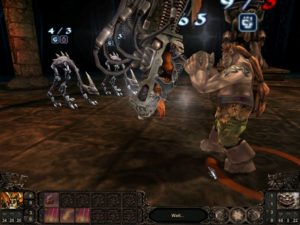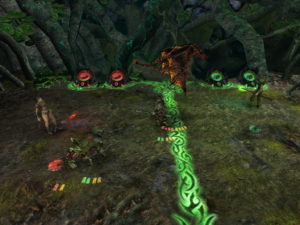Well, that didn’t take long. It seems that all it really takes to motivate me to keep playing a game without pause until I reach the end is continual tangible progress. As in, the kind of progress that doesn’t happen when you’ve got the difficulty set too high.
I should mention that part of the reason it took me less time than I was expecting was that I made some discoveries about the user interface that got things going faster. It turns out that you can skip most animations by pressing the space bar, which I apparently hadn’t tried before. Well, it’s a highly mouse-driven game in most other respects. In most of my sessions, I didn’t even touch the keyboard, and I probably still wouldn’t have tried it if I weren’t recently involved in some space-bar-skippable animations in a different context. I knew that Etherlords lets you turn animations off entirely through the options menu, but I had found this to produce glitches, and besides, I didn’t want to turn them off entirely. Watching the animations is part of the charm of the game. At least, it is the first few times for each type of monster. But I was stuck for ages on a level where I was playing Team Black, which has Mech Worms as its basic starting unit, and not only do Mech Worms have a frustratingly slow crawling-forward-to-attack animation, they automatically attack every round (that is, they have the “berserk” attribute). So I was very glad to not have to sit through that again.
But even with that assistance, I couldn’t have breezed through the remainder of the game in the span of a day if I hadn’t been unexpectedly close to the end. In my last post, I was on level 5. It turns out that there are only 7 or 8 levels, depending on how you count the end boss.
Map 6 shakes things up a little by giving you no castle, and thus no way to cast overland spells, such as the spell that summons new heroes. So, you’re stuck with what you start with — a traditional variation found in strategy games of this sort. Usually such levels derive tension from the slow attrition of your irreplacable troops, but since Etherlords heals your heroes completely between battles, that’s not really a factor here. The map does limit the resources you need to cast spells, but you can pick up more stuff from monsters, and at any rate, it just doesn’t feel the same.
Map 7 is where the alliances finally break apart. You’re on the threshhold of the grand prize, so it’s every etherlord for himself. I’ve been playing the red/black campaign, so at this point I had to choose red or black. I chose red — that’s the team that has my O(n2) kobolds, which proved quite useful. Ultimately, though, I didn’t need my heroes to defeat my three computer-controlled rivals. This is a really big map, with a lot of mines and ether nodes scattered around, and once you have above a certain threshhold of spell fuel coming in every turn, you can destroy the opponent castles with overland spells alone. You don’t even have to know where the castles are, which is fortunate, because even after I had destroyed them, it took me a while to find them. At any rate, the real bosses of the level are the level 12 dragons, the most powerful beings in the game up to that point, who guard the entrance to the Temple of Time, where the final challenge awaits.
The final level doesn’t even have a map. It’s just a duel against the White Lord, holder of ultimate power over the cosmos. It is this power that the etherlords crave; your goal is to kill him and take his place. He’s level 15. But for the final fight, you get a level 15 character as well, and you get to choose whatever assortment of spells you feel like, provided of course that they’re your color. (The White Lord is not limited to one color.)
Now, this was clearly going to be a high-powered fight. High-level characters have more hit points and get mana faster than low-level characters, and these were the two highest-level characters I had ever seen. So I figured I should try the Mana Burn trick. Mana Burn is an enchantment that makes unused mana hurt. It cuts both ways, though, so if you use it, you have to be sure you have some kind of mana sink — something that has a power-up effect that can use arbitrary quantities of mana — so that your own excess mana doesn’t damage you. There are a couple of “wall”-type summonables (things that can’t attack but can block attacks) that fit the bill. Anyway, it seemed like this approach would be a good fit for a long fight with lots of hit points, because the number of open mana channels just keeps on increasing, and there’s only so much an unprepared opponent can do with them.
Apparently the designers of the game came to the same conclusion: the White Lord also used the Mana Burn strategem, but did it better than me. I couldn’t even imitate what he did, because of the way he mixed colors. It took me five or six tries to catch onto a winning modified strategy, mixing in some Cyclopes and some Disintegrate spells. (The advantage of Disintegrate is that it removes creatures from play entirely, so they can’t regenerate or rise from the dead. The White Lord had some things that kept coming back.)
 At which point it turned out to be one of those two-stage boss fights, with the real White Lord showing up encased in some kind of robotic life support tube or something. This time he’s level 20, and uses a completely different strategy, involving creatures with the special property that they can’t be targetted by spells, which rendered my lovely Disintegrates useless. Nonetheless, I managed to get past this part on my first try, although it was a close thing.
At which point it turned out to be one of those two-stage boss fights, with the real White Lord showing up encased in some kind of robotic life support tube or something. This time he’s level 20, and uses a completely different strategy, involving creatures with the special property that they can’t be targetted by spells, which rendered my lovely Disintegrates useless. Nonetheless, I managed to get past this part on my first try, although it was a close thing.
And so I hand over ultimate power to the Chaots, the fire-and-bloodhshed faction. This isn’t going to be a pleasant eon. Of course, eventually the stars will align again and someone else will come to challenge the new White Lord — it’s that sort of ending. I suppose that if I don’t actually sympathize with the player character, there’s at least some consolation in knowing that he’s going to be locked up in that temple for a few thousand years.
At this point, you might be wondering about the other sides. There are two separate campaigns — or four, once you’re past map 6. Can I really say I’m finished with the game if I’ve only completed one? This is really something tha varies from game to game. In Starcraft, for example, playing only one side would be ludicrous — you’d be missing out on 2/3 of the gameplay, not to mention 2/3 of the plot. But Etherlords is much more symmetrical than that. From what I’ve seen of the campaigns, it’s clear that they really only differ significantly at the tactical level, in combat mode. I’ve seen what campaign mode has to offer, and don’t need to see the same thing from the other side. But I am kind of curious about the end boss. The Mana Burn gimmick is something only available to the Chaots. How do the other sides deal with it? Does the White Lord, in fact, choose different decks depending on who invades his sanctum? If I ever decide to play this game more, it’ll be to satisfy my curiosity on those questions.
 Comments(0)
Comments(0)
